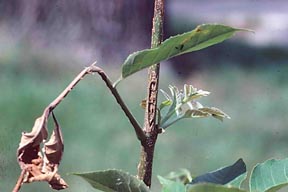Periodical Cicada Emergence | |
|---|---|
| April 11, 2007 | |
|
We are expecting a large emergence of periodical cicada in northern Illinois this spring. Cicadas are expected to emerge north of a line from northern Iroquois County on the east, dipping southward to northern Sangamon County in the center of the state, and then rising northward to the Moline and the other Quad Cities on the west. This is the Northern Illinois Brood, also known as Marlatt's XIII brood. They last emerged 17 years ago, in 1990.  Avoid planting small trees in heavy-emergence areas this spring. After mating, the female cicada uses her ovipositor, or egg-laying device, to slice several inch-long crevices in twigs and branches to lay their eggs. Small transplanted trees, particularly fruit trees, commonly have a trunk diameter small enough that egg slits are made in the trunk, resulting in the tree snapping off.  Insecticide applications kill huge numbers of visiting cicadas, but analysis of egg-slit trunk damage shows little difference between treated and untreated research plots. In fact, Fredric Miller found similar results in insecticide-efficacy research conducted in the Chicago area in 1990. The only way to protect small trees from serious damage in a heavy-emergence area is to protect the trunk with screening or other material. This is expensive in materials and labor. It is much better to delay small-tree planting for a year or install larger stock, preferably those with a trunk diameter of at least 2-1/2 inches. Emergence of periodical cicadas is not heavy in many areas, so tree planting can continue there. These areas are very predictable. The memories of people living in particular areas during the 1990 emergence are very useful. Similarly, local newspaper accounts can be useful. Some thought about periodical cicadas and their needs can also help. Realize that these insects require a steady supply of sap-supplying tree and shrub roots for 17 years. Housing developments in which all trees and shrubs were removed prior to building will have few cicadas because the nymphs died when the trees were removed. Similarly, housing developments in areas that were originally farm fields or prairie will have few cicadas due to the lack of trees. The practice of bulldozing all trees off of a housing development site has been common only since the 1960s, so older housing developments probably will have large numbers of cicadas. | |
| Author: | Phil Nixon |
